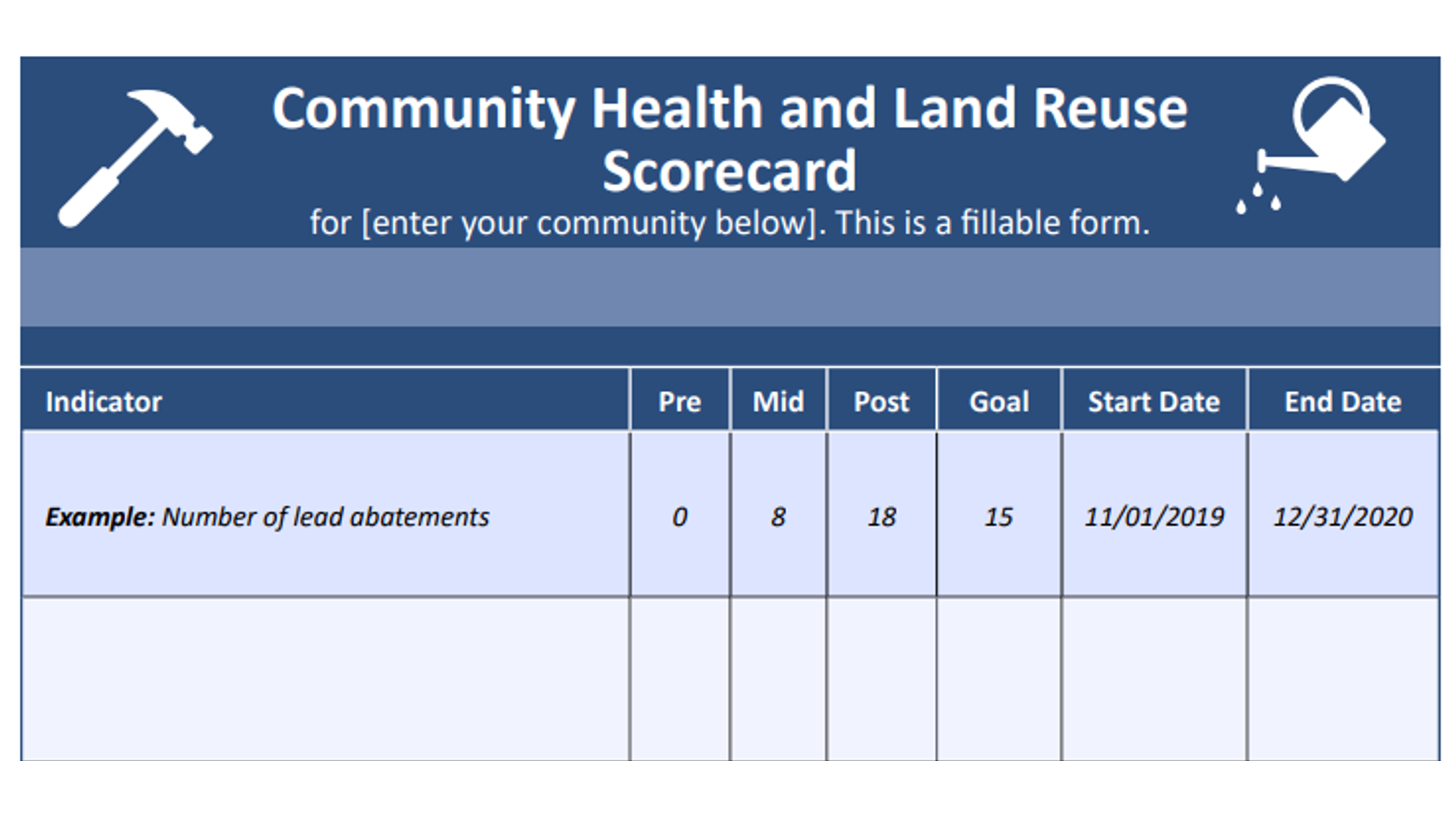What to know
ATSDR’s Community Health and Land Reuse Scorecard Toolkit helps communities track progress and evaluate their land reuse and redevelopment efforts.

Build Your Community Health and Land Reuse Scorecard Toolkit
The Toolkit consists of:
- A selection of community-derived indicators to consider based on program activities, goals, and stakeholders;
- A blank scorecard template for communities to track progress and change over the course of their redevelopment projects.
From 2010-2018, over 45 different communities across the U.S. used the Action Model in health-focused redevelopment planning. As part of Action Model Step 4: Data Needed to Measure Change, communities developed indicators to evaluate change in various aspects of overall community health (e.g. physical health, economy, environmental improvement, other). Indicators are specific and measurable characteristics or information that help determine if a program is implemented as expected and achieving its outcomes. ATSDR consolidated indicators developed from 40 of these Action Models to create a set of 69 community-derived indicators associated with land reuse and redevelopment. All indicators were common to at least 20% of communities. ATSDR grouped the indicators according to nine categories selected by the communities:
- Built Environment (17 indicators)
- Community Involvement (4 indicators)
- Economy (16 indicators)
- Education (4 indicators)
- Environmental Improvement (6 indicators)
- Environmental Resource Indicators (5 indicators)
- Housing (11 indicators)
- Physical Health (4 indicators)
- Safety and Security (2 indicators)
Using the Action Model, your community can incorporate any of the indicators for your own redevelopment plans. You can collect data for the indicator at the start of redevelopment and again at key points in time during and after redevelopment to track the implementation of activities and changes in environment and health.
Community Health and Land Reuse Scorecard
The Community Health and Land Reuse Scorecard is a tool for your community to use in evaluating your land reuse/redevelopment project. It can help you to:
- Track activities and help determine if the project is being implemented as expected
- Track progress on outcomes to help demonstrate measurable accomplishments or changes toward achieving an outcome.
Based on your program design, stakeholders, and evaluation plans, you can select applicable indicators from the community-derived indicators or create your own. Indicators are specific, measurable information used to determine if a program is implemented as intended and/or achieving its outcomes. Many times 1-2 indicators per key activity or outcomes is sufficient. However, the number of indicators you collect depends on what you want to evaluate. The following criteria can help in selecting the best indicators for your activities:
- Relevance: Aligns with Development Community's concerns, planned activities, intended outcomes, and key evaluation questions
- Specific: Provides a clear description of what will be measured
- Measurable: Can be quantified, and many times is reported in numerical terms
- Practical: Can be feasibly collected with a reasonable amount of resources
- Direct: Measures the intended result
- Attributable: Demonstrates the extent to which results are caused by your activities
Once you and your Development Community have selected the indicators that best fit your community redevelopment vision and plans, fill in the scorecard using the suggested steps below.
How do I use the Community Health and Land Reuse Scorecard?
You can download the Community Health and Land Reuse Scorecard Toolkit template. This template is a fillable PDF. You can type directly into this form, and you have options to save it, reset it, or print it.
Indicator: Select an indicator from the lists of community-derived indicators by copying and pasting or taking a "snapshot" and then pasting, or create and write-in your own.
Pre: Collect data for your indicator and record the measure before you begin redevelopment activities.
Mid: Collect data for your indicator and record the measure at the midpoint of your project, if applicable. Whether it's necessary to measure mid-point progress depends on your programs goals and what you want to evaluate.
Post: Collect data for your indicator and record the measure after you end redevelopment activities.
Goal: Set a goal for the post-value of each indicator before you begin your activities. Think about what represents success at the end of your project, is realistic within the timeline, and reflects Development Community's values.
Start Date: Record the start date of activities to add context to your results.
End Date: Record the end date of activities to add context to your results.
Note: The Community Health and Land Reuse Scorecard is designed for quantitative indicators. Sometimes what is important isn't always quantifiable, so remember to collect qualitative data (stories, descriptions, interviews, focus groups, written content, pictures, etc.) when applicable.
You can transfer indicators from your own Community Health and Land Reuse Scorecard template directly into your existing Action Model Step 4.
Community-derived Indicators
To select indicators, click on the icons corresponding to nine community health categories, below.
Community Involvement Indicators
Environmental Improvement Indicators

